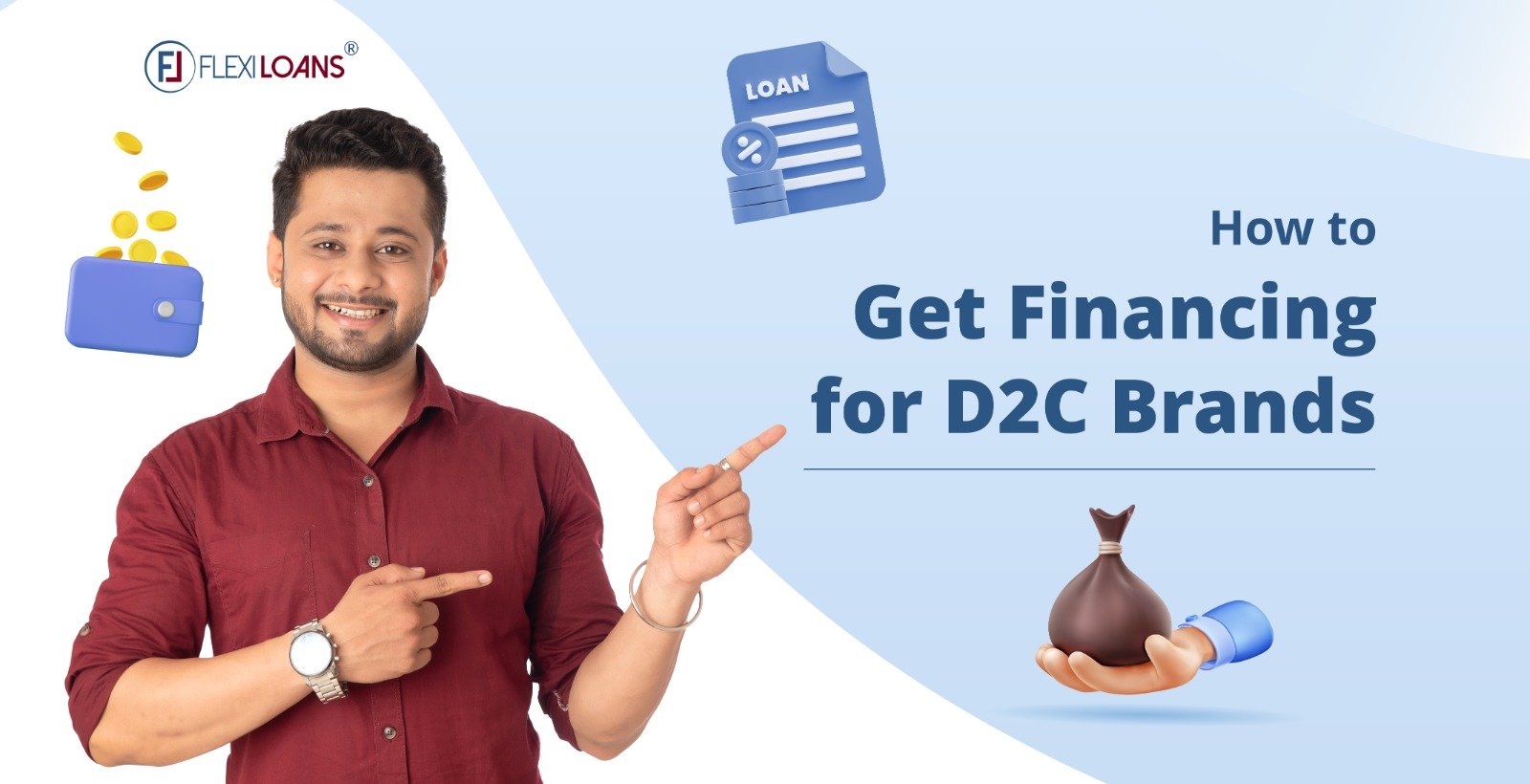Jan 10, 2024
Oct 01, 2025

Direct-to-consumer (D2C) brands sell their products or services directly to their customers without relying on intermediaries like retailers, wholesalers, or distributors. D2C brands have grown rapidly thanks to the advantages of digital technology, e-commerce platforms, social media marketing, and customer data analytics.
These businesses have a higher profit margin. They cut out the middlemen and enjoy lower operational costs. However, D2C brands face challenges regarding funding and scaling up. Unlike traditional businesses, D2C brands must invest more in product development, customer acquisition, retention, and brand awareness.
Today, we will compare and contrast four main financing options available for D2C brands.
1. Bootstrapping
Bootstrapping means starting and growing a business using your own funds. You don’t seek external financing from investors or term loan providers. Bootstrapping is a popular option for D2C brands, especially in the early stages of development, when they have a limited budget and a high risk of failure.
Advantages
- You have full ownership and control over your business without having to share your equity or decision-making power with anyone else.
- You have no obligations or repayment pressure from investors or lenders, who may have different expectations or interests than you.
- You can concentrate on your core business tasks without becoming distracted by fundraising or reporting responsibilities.
Disadvantages
- You have limited growth potential, as you can only rely on your own funds and cash flow, which may not be enough to cover your expenses or expand your operations.
- You expose yourself to high personal risk. You might have employed your savings, assets, or credit cards to finance your business, impacting your financial stability or credit score.
- You have a low brand image, as you may not be able to afford professional marketing, advertising, or public relations services, which may affect your credibility or visibility in the market.
Tips to Use Bootstrap Effectively
- Find your niche. Identifying a specific problem or need that your target customers have. Offer a unique solution that differentiates you from your competitors.
- Create a minimum viable product (MVP). Build a basic form of your product or service that delivers the core value proposition to your customers. Test it in the market to get feedback and validation.
- Test your product-market fit (PMF) by measuring how well your product or service satisfies your customers’ needs and expectations and how likely they are to buy, use, and recommend it to others.
- Optimise your marketing channels. Choose the most efficient ways to reach, engage, and convert your potential and existing customers, such as email, social media, content, SEO, etc.
- Leverage social media platforms. Create and share valuable content demonstrating your brand personality, story, and values that encourage your customers to interact with you and spread the word about you.
2. Venture Capital
Venture capital is financing that provides funds to start-up or early-stage businesses with high growth potential for equity or ownership shares. It is a common option for D2C brands, especially in the later stages of development, when they have proven their product-market fit and traction and need to scale up their operations. Some pros and cons of this MSME loan are:
Advantages
- You can access substantial funding from multiple sources, such as venture capital firms, funds, or networks, who may have millions or billions of dollars to invest in promising businesses.
- You can benefit from technical support and expert guidance from your investors or advisors, who may have extensive experience, knowledge, and connections in your industry or market and can help you with strategy, management, hiring, and partnerships.
Disadvantages
- You must renounce control by offering investors a portion of your equity or shares. They may hold voting rights or veto power over your decisions.
- You must face high pressure to meet targets, as you must deliver on your promises and expectations to your investors, who may have aggressive or unrealistic goals or timelines for your growth, revenue, or profitability.
- You must deal with distraction from your core business activities, as you have to spend a lot of time and effort on fundraising, pitching, negotiating, reporting, and communicating with your investors, who may have different opinions or agendas than you.
Tips to Use Venture Capital Effectively
- Have a clear value proposition. Articulate what problem you are solving, your target customers, and how your product or service is different or better than your competitors.
- Build a strong team by assembling a group of talented people who share your vision and values and have complementary skills.
- Prepare a compelling pitch deck by creating a concise and captivating presentation covering your business’s critical aspects.
3. Angel Investment
Angel investment is a type of business loan where an individual or a group of individuals, known as angel investors, provide capital to a startup or an early-stage business in exchange for equity or convertible debt. Angel investors are usually wealthy people with experience in the industry or sector they invest in. They often offer more than money, such as mentoring, advice, connections, and resource access.
Advantages
- They are more flexible and less demanding than venture capitalists. They can provide more suitable terms, such as less dilution and fewer restrictions on how you use the money.
- They are more willing to take risks and invest in innovative and niche ideas that might not appeal to venture capitalists. They can also offer valuable feedback and insights from their experience and network.
- Angel investors can help you build your brand reputation and credibility, as they can act as advocates and endorsers for your product or service.
Disadvantages
- Angel investors are harder to find and reach than venture capitalists. You might need to rely on personal contacts, referrals, or platforms that connect entrepreneurs and investors.
- They usually provide smaller amounts of money than venture capitalists. You might need to raise or combine multiple angel investment rounds with other funding sources, such as crowdfunding, grants, or loans.
- Angel investors might have different expectations and goals than you. They might want to exit the business sooner or later than you or have different opinions on how to grow and scale the business.
Tips to Use Angel Investment Effectively
- Do your research and target the right angel investors who have experience and interest in your industry or sector.
- Build relationships and trust with the angel investors before asking for money. You can reach out to them via email, social media, or events.
- Prepare a pitch deck that is concise, clear, and compelling.
- Practice your pitch and get feedback from mentors, peers, or customers. You can also join pitch competitions, demo days, or accelerator programs to showcase your product or service and get exposure to potential investors.
4. Revenue-Based Financing
This type of small business loan provides flexible payment terms based on your future revenue streams. Unlike traditional loans or equity investments, RBF does not require upfront cash payments, fixed interest rates, or ownership stakes. Instead, RBF providers offer you a lump sum for a percentage of your monthly revenue until you pay back a predetermined amount.
Advantages
- It has a low cost. You don’t have to pay unsecured business loan interest rate or fees to the RBF provider, only a fixed percentage of your revenue.
- You don’t have to give up equity or ownership to the RBF provider.
- You don’t have to share your decision-making power or information with the RBF provider.
Disadvantages
- You may not get enough funds to start or grow your business, as RBF is based on your existing revenue.
- Depending on your revenue performance, you may have to pay more or less, which may be unpredictable or volatile.
Tips to Use Revenue-Based Financing Effectively
- Show that you have a loyal and increasing customer base who love your product or service and are willing to pay for it.
- Demonstrate that you have a scalable and prosperous business model that can generate consistent and recurring revenue streams.
- Highlight your competitive edge.
Conclusion
When financing your D2C brand, consider the pros and cons of each option. Bootstrapping offers control but limited growth, while venture capital provides substantial funding but demands relinquishing control. Angel investment offers flexibility, and revenue-based financing aligns with your revenue streams. Choose wisely to propel your brand forward.
FAQs
Bootstrapping is initiating a business using personal funds and the generated revenues without relying on external capital.
Venture capital (VC) is financing investors provide to startups with long-term growth potential. It often includes substantial funding and technical support from experienced entrepreneurs, which can significantly accelerate a D2C brand’s growth.
Angel investors provide a one-time investment in exchange for a higher return. Unlike VC, which may involve financial institutions, angel investments are more personal and can offer mentorship.
Companies with rapid growth potential and those needing heavy infrastructure, such as manufacturing firms, should opt for external financing to meet their scaling requirements.
RBF is a funding option where repayments are tied to the company’s revenue, making it a flexible solution for D2C brands.
Once a D2C brand secures RBF, it can stabilise its operations and demonstrate growth, making it more attractive for larger funding from banks and venture capitalists.
Technology platforms can assist D2C brands in making informed decisions about financing options and connecting with the right investors or lenders.
Bootstrapping can limit growth, take longer to achieve business goals, and involve personal financial risks. It may also affect the company’s image among customers and suppliers.







